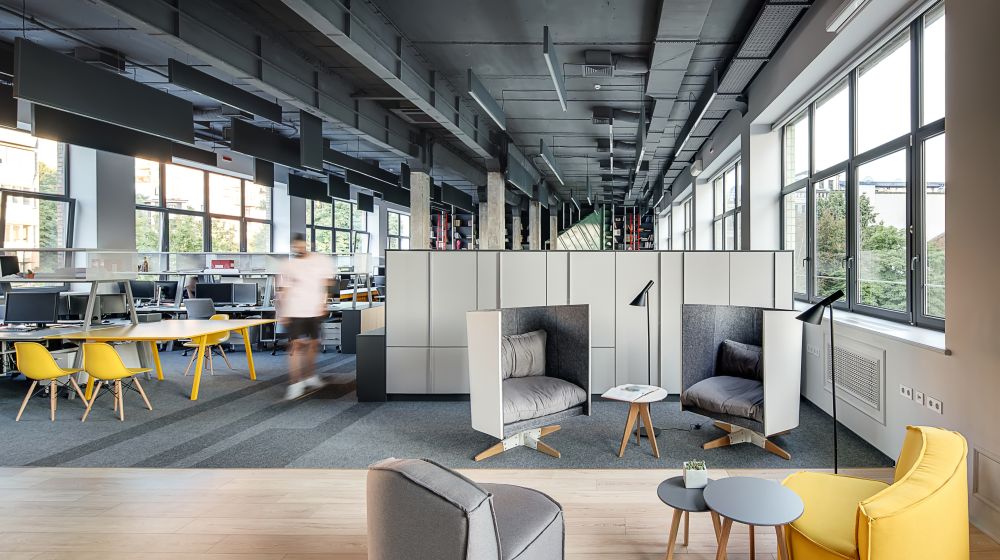Technological Offerings in Modern Coworking Spaces
Present day cooperating spaces are furnished with trend setting innovations intended to upgrade efficiency, availability, and joint effort among individuals. By incorporating cutting-edge technology to meet the diverse requirements of today’s digital workforce, these settings go beyond conventional office layouts. Discover the versatility and collaborative spirit of shared spaces, designed to foster creativity and innovation.
Access to a fast internet connection:
One of the central advances in present day cooperating spaces is high velocity web network. In order to facilitate seamless communication, file sharing, video conferencing, and online collaboration, spaces typically provide high-bandwidth, reliable Wi-Fi connections. Members of the coworking space can work effectively and without interruptions thanks to the fast internet speeds.
Tech-Prepared Gathering Rooms:
Audiovisual equipment like large projectors, sound systems, and video conferencing tools can be found in modern coworking spaces’ tech-equipped meeting rooms. These conveniences work with virtual gatherings, introductions, and cooperative meetings among groups or with outer clients, improving correspondence and efficiency.
Work area Mechanization and Shrewd Arrangements:
Coworking spaces streamline operations and enhance member experience by utilizing smart solutions and workspace automation. Automated booking systems for meeting rooms and amenities, smart lighting and climate control systems that adapt to occupancy or member preferences, and IoT (Internet of Things) devices that maximize energy efficiency and resource management are examples.
Software and Tools for Collaboration:
To help joint effort and undertaking the board, current cooperating spaces give admittance to cooperative devices and programming. For real-time messaging, file sharing, and task management, members can use cloud-based storage solutions, project management platforms, and communication tools like Slack or Microsoft Teams. These instruments work with consistent collaboration and data dividing between collaborators, no matter what their actual area.
IT Services and Support:
To assist members with technical issues, troubleshooting, and equipment setup, many coworking spaces provide on-site IT support and services. IT experts give convenient help, guaranteeing that individuals can determine innovation related moves rapidly and limit disturbances to their work.
In Conclusion, cutting edge cooperating spaces are furnished with a scope of trend setting innovations that help efficiency, network, and coordinated effort among individuals. The overall work experience in coworking environments is enhanced by these technologies, which include smart solutions, collaborative tools, cybersecurity measures, IT support services, high-speed internet connectivity, and meeting rooms that are tech-equipped. By embracing imaginative tech arrangements, cooperating spaces engage experts to work proficiently, team up really, and flourish in unique and interconnected work areas. Explore modern amenities and flexible usage options available in shared space shared spaces, ideal for dynamic working environments.

現代共享辦公空間的技術產品
當今的合作空間配備了引領潮流的創新,旨在提高效率、可用性和個人之間的共同努力。透過融入尖端技術來滿足當今數位化員工的多樣化需求,這些設置超越了傳統的辦公室佈局。發現多才多藝和協作精神 共用 空間 共享空間,旨在促進創造力和創新。
存取快速的網路連線:
當今合作空間的主要進步之一是高速網路。為了促進無縫通訊、文件共享、視訊會議和線上協作,空間通常提供高頻寬、可靠的 Wi-Fi 連線。由於快速的網路速度,共享辦公空間的成員可以有效率、不間斷地工作。
技術準備好的聚會室:
在現代共享辦公空間的技術配備齊全的會議室中可以找到大型投影機、音響系統和視訊會議工具等視聽設備。這些便利性與團體之間或與外部客戶的虛擬聚會、介紹和合作會議相結合,提高了溝通和效率。
工作區域機械化、精明安排:
共享辦公空間利用智慧解決方案和工作空間自動化來簡化營運並增強會員體驗。例如,會議室和設施的自動預訂系統、適應佔用或會員偏好的智慧照明和氣候控制系統,以及最大限度提高能源效率和資源管理的物聯網(IoT)設備。
協作軟體和工具:
為了幫助共同努力和董事會,目前的合作空間允許合作設備和程序。對於即時訊息傳遞、檔案共用和任務管理,成員可以使用基於雲端的儲存解決方案、專案管理平台以及 Slack 或 Microsoft Teams 等通訊工具。這些工具可以在協作者之間進行一致的協作和資料劃分,無論他們的實際領域是什麼。
IT 服務與支援:
為了幫助會員解決技術問題、故障排除和設備設置,許多共享辦公空間提供現場 IT 支援和服務。 IT專家提供便利的協助,確保個人能夠快速確定與創新相關的措施並減少對其工作的干擾。
總而言之,前沿的合作空間配備了一系列引領潮流的創新,有助於提高效率、人脈和個人之間的協調努力。這些技術增強了共享辦公環境中的整體工作體驗,其中包括智慧解決方案、協作工具、網路安全措施、IT 支援服務、高速網路連接和配備技術的會議室。透過採用富有想像力的技術安排,合作空間讓專家能夠熟練地工作,真正地團隊合作,並在獨特且相互關聯的工作領域中蓬勃發展。探索共享空間中提供的現代化設施和靈活的使用選項,是動態工作環境的理想選擇。



